Cold water therapy, also known as cold hydrotherapy, is gaining traction as a popular method for improving health and well-being. This therapeutic practice involves immersing the body in cold water or exposing it to cold temperatures for short periods.
Among the various forms of cold water therapy, ice baths are particularly favoured for their extensive benefits. In this blog post, we’ll delve into the history, benefits, methods, and precautions associated with cold water therapy, with a focus on why ice baths might be the best choice for many.
History and Origins
Cold water therapy is not a new concept; it has been practiced for centuries across different cultures. Ancient Greeks and Romans used cold baths for relaxation and recovery. In the 19th century, Vincent Priessnitz, an Austrian farmer, popularised hydrotherapy in Europe, advocating for cold water treatments to promote healing.
Today, modern science is catching up with these ancient practices, providing evidence to support the benefits of cold water exposure.
Benefits of Cold Water Therapy
1. Reduced Muscle Soreness and Inflammation
One of the primary reasons athletes and fitness enthusiasts opt for ice baths is to reduce muscle soreness and inflammation. Post-exercise, muscles can become inflamed, leading to soreness. Immersing the body in cold water can constrict blood vessels and reduce metabolic activity, which helps to minimise swelling and tissue breakdown.
A study published in the Journal of Athletic Training found that cold water immersion can significantly reduce delayed onset muscle soreness (DOMS) .
2. Enhanced Circulation
Cold water therapy can improve circulation. When the body is exposed to cold, blood vessels constrict, and upon rewarming, they dilate, leading to a rush of blood through the body.
This process can help to flush out metabolic waste from tissues and deliver oxygen and nutrients, enhancing overall circulation. Improved circulation can also promote cardiovascular health and boost the immune system .
3. Boosted Mental Health and Well-being
The impact of cold water on mental health is profound. Immersing in cold water triggers the release of endorphins, also known as ‘happy hormones’, which can alleviate symptoms of depression and anxiety.
Moreover, the act of overcoming the discomfort of cold water can build mental resilience and improve overall mood. According to research published in the British Journal of Sports Medicine, cold water immersion has been shown to reduce symptoms of anxiety and improve overall mental well-being .
4. Enhanced Recovery and Performance
Cold water therapy, especially ice baths, can accelerate recovery after intense physical activity. By reducing muscle soreness and inflammation, athletes can return to training faster and with less discomfort. This enhanced recovery is crucial for maintaining performance levels and avoiding overtraining injuries .
5. Improved Sleep Quality
Exposure to cold water can also improve sleep quality. The body’s response to cold temperatures can help to regulate the sleep-wake cycle and promote deeper, more restful sleep. Improved sleep quality is essential for recovery, mental health, and overall well-being .
Methods of Cold Water Therapy
1. Ice Baths
Ice baths involve immersing the body in a bath of ice-cold water, typically between 0-15°C (32-59°F). This method is highly effective for reducing muscle soreness and inflammation.

2. Cold Showers
Cold showers are a more accessible form of cold water therapy. They involve turning the water temperature to cold for a few minutes at the end of a regular shower. While not as intense as ice baths, cold showers can still provide benefits such as improved circulation and enhanced mental alertness.
3. Cold Water Swimming
Swimming in cold natural waters, such as lakes or oceans, is another method of cold water therapy. This method combines the benefits of cold water immersion with the physical activity of swimming. However, it is crucial to ensure safety and check water temperatures before diving in.
4. Cryotherapy
Cryotherapy involves exposing the body to extremely cold temperatures for a short period, usually in a controlled environment using cryo-chambers. While effective, cryotherapy can be expensive and less accessible compared to ice baths and cold showers.
Why Ice Baths are the Preferred Method
1. Controlled Environment
Ice baths offer a controlled environment where the temperature and duration can be precisely managed. This control is crucial for ensuring safety and maximising benefits. Unlike cold showers or natural water swimming, you can adjust the ice bath to suit your comfort level and gradually increase the intensity as you become more accustomed to the cold.
2. Targeted Therapy
Ice baths allow for targeted therapy, especially for athletes focusing on recovery. The entire body can be submerged, ensuring that all muscle groups benefit equally from the cold exposure. This comprehensive approach is particularly beneficial for those recovering from whole-body workouts or sports activities.
3. Proven Efficacy
Numerous studies have highlighted the efficacy of ice baths in reducing muscle soreness, inflammation, and enhancing recovery. This proven track record, backed by scientific research, adds to the credibility and appeal of ice baths as a preferred method of cold water therapy .
Precautions and Safety Tips
While cold water therapy offers numerous benefits, it is essential to approach it with caution to avoid potential risks. Here are some safety tips to consider:
1. Gradual Adaptation
If you are new to cold water therapy, start gradually. Begin with short cold showers and slowly increase the duration and intensity. This gradual adaptation helps your body to acclimate to the cold and reduces the risk of shock or discomfort.
2. Monitor Temperature
Always monitor the temperature of the water. For ice baths, aim for a range between 10-15°C (50-59°F). Water that is too cold can cause hypothermia or frostbite, while water that is not cold enough may not provide the desired benefits.
3. Limit Duration
Do not exceed the recommended duration of 10-15 minutes for ice baths. Prolonged exposure to cold water can lead to hypothermia and other health issues. Use a timer to ensure you do not overstay in the ice bath.
4. Listen to Your Body
Pay attention to how your body reacts to cold water therapy. If you experience severe discomfort, numbness, or any adverse reactions, discontinue the therapy immediately and seek medical advice if necessary.
5. Consult a Healthcare Professional
Before starting cold water therapy, especially if you have pre-existing health conditions or concerns, consult a healthcare professional. They can provide personalised advice and ensure that cold water therapy is safe for you.
Cold water therapy, particularly ice baths, offers a multitude of benefits ranging from reduced muscle soreness and enhanced recovery to improved mental health and sleep quality. With a rich history and growing body of scientific evidence supporting its efficacy, cold water therapy is a valuable practice for anyone looking to improve their overall health and well-being.
Ice baths, with their controlled environment, targeted therapy, and proven benefits, stand out as the preferred method of cold water therapy. By following safety guidelines and gradually incorporating this practice into your routine, you can harness the power of cold water to enhance your physical and mental health.
Sources:
- Journal of Athletic Training – Cold Water Immersion Reduces Delayed Onset Muscle Soreness
- American Heart Association – Cold Water Therapy for Circulation
- British Journal of Sports Medicine – Mental Health Benefits of Cold Water Immersion
- Journal of Strength and Conditioning Research – Recovery and Performance with Cold Water Therapy
- Sleep Medicine Reviews – Cold Water Therapy and Sleep Quality
- Sports Medicine – Efficacy of Ice Baths

